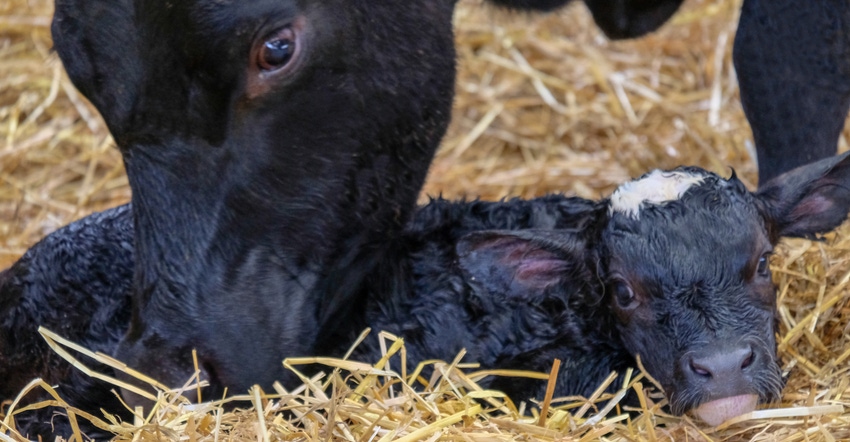March 1, 2022

Calving season is an exciting time as we gear up to welcome our newest calf crop into the world. Help make it the most successful season possible by ensuring adequate colostrum, preventing cold stress and having a calving kit ready.
Here are three tips:
1. Ensure adequate colostrum. Calves are born agammaglobulinemic, meaning they have almost no antibodies to protect them against disease. Simply, they're not born with any immune memory that we develop over our lifetimes — they receive those antibodies, an immediate source of immunity, and a very concentrated source of energy from their cow’s colostrum (the first milk produced following birth).
Colostrum delivers some 95% of the antibodies a calf obtains, plus a rich source of minerals, vitamins and energy. It provides protection for newborn calves against infectious agents during the first few months of life.
Colostrum absorbance has a 24-hour window. That short time influences a calf’s lifetime of health and productivity. Because antibodies are very large molecules, the calf’s intestine is only capable of absorbing this protection immediately after birth, with essentially no absorption possible after the first 24 hours.
Within the first 12 hours of a calf’s life, ideally within the first four to six hours of life, these calves should receive 3 to 4 quarts of colostrum.
Depending on if the calf nurses or not, we might have to tube them and get some colostrum replacers or colostrum supplements into them. Keep in mind, there are colostrum supplements and colostrum replacers, and there is a difference.
Colostrum replacers have roughly double the level of antibodies in them, compared with colostrum supplements. If your calf doesn't receive any colostrum, then we would recommend giving them a colostrum replacer.
Colostrum supplements work well in circumstances where a calf might not have nursed enough, for calves born from heifers, or if you fear the cow’s colostrum quality could be lacking. Colostrum supplements can also offer a good source of energy, fat and protein to help jump-start sick calves.
2. Keep chilled calves warm. The most severe result from cold stress on calves is death from hypothermia. If possible, bring cows indoors to a calving shed or barn to calve in a heavily bedded, clean pen for added warmth and reduced moisture.
If calving outdoors, an area mostly free of mud and manure — with a windbreak — is ideal. Cold stress and hypothermia can pose great risk to calves, especially if calves experience dystocia, which often results in delayed standing and nursing. Both can quickly lower their body temperature.
A cold calf is going to be slow and a little lethargic — they might not want to stand up. If their nose or extremities like their feet or right above their feet feel cold, then most likely they need warming.
Beware the signs of hypothermia, which include:
body temperature below 94 degrees F
shivering
increased pulse and breathing rate
erratic behavior
confusion and uncoordinated gait
cold, pale nostrils and hooves
It’s critical to return the calves to their normal core body temperature of 102 degrees. There are several ways to do this, such as placing them under a heat lamp, warm blankets, bringing them indoors, or giving them a warm bath (warmed gradually), or putting the calf into a warming box.
I personally find there to be more practical methods than, let's say, a warm-water bath. Let's face it; often there's a lot of moisture, snow and mud. So, after a warm-water bath indoors, we have to dry off calves completely before returning them to the cow. The practice can be labor intensive.
There are calf warmers that can dry them off as the unit warms the calf. Another benefit is, when inside the warmer, the calf is actually breathing in warm air, helping to warm them internally, as well. That's my favorite way to warm a chilled calf.
As far as when we need to warm them up, I recommend warming if their body temperature falls below 100 degrees. Producers will also need to consider windbreak availability and what environmental conditions are like. If it's extreme enough, drying and warming every calf could be necessary.
3. Have a stocked calving kit. It’s better to have it and not need it, than to need it and not have it — and that’s especially true as we head into calving season. I recommend having a calving kit on hand.
Here are some items I’ve always valued having in mine:
calf resuscitator
calf-pulling chains
OB handles
stainless steel pail
chlorhexidine disinfectant solution
OB sleeves
OB lube
iodine or umbilical spray
colostrum replacers and supplements
Learn more about calving and cattle health solutions at valleyvet.com.
Hawkins is a Valley Vet Supply technical service veterinarian.
You May Also Like




